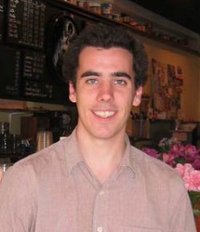Ambitious Project Links Health Outcomes, Socioeconomic Data
 How is the socioeconomic status of one generation dependent on that of their parents? Economics Professor John Parman has launched an ambitious project to address this question using a wealth of internet-accessible data.
How is the socioeconomic status of one generation dependent on that of their parents? Economics Professor John Parman has launched an ambitious project to address this question using a wealth of internet-accessible data.
“My project examines long-run economic and health outcomes and the ways in which childhood household characteristics affect those outcomes,” says Parman. “We are building a database containing individual-level data on chronic health problems, cause of death and age at death, occupational information, and childhood household characteristics from historical census records and death certificates.”
Currently Parman is in the data-gathering phase. He is working with William and Mary students to code individual records using the state of North Carolina as his data pool.
“For the twentieth century, ancestory.com has 2.2 million electronic death certificates for North Carolina dating back to 1909,” says Parman. Death certificates for the project are chosen from ancestory.com using a computer-generated random-selection process. Each certificate is coded manually, and data such as age of death and cause of death are entered into a massive spreadsheet.
Parman’s team then finds the same individual in the online U.S. Census. From the census data, they are able to code childhood information such as birthdate, siblings, parents' jobs, where they lived, and more. Using county records for the time, another set of data for the individual’s childhood conditions are added by looking at the area's disease-incidence rates, mortality rates, and the county’s industrial/agricultural mix.
“Only in the last few years do we have access to large-scale amounts of this information,” says Parman, who hopes to have tens of thousands of entries prepared by the end of the year. “This is a new way of looking at things, and as far as I know I’m the only one doing it.”
 “It is really interesting work, and I’m gaining some great research experience,” says Economics major Elianne Chung '12, one of six students working with Parman to transcribe information from death certificates and census records, code that information, and link individuals across historical documents.
“It is really interesting work, and I’m gaining some great research experience,” says Economics major Elianne Chung '12, one of six students working with Parman to transcribe information from death certificates and census records, code that information, and link individuals across historical documents.
“I also want to have students involved in analyzing the data,” says Parman. “It’s like an electronic internship with great flexibility.”
In addition to looking at economic mobility, Parman will assess how the last century’s changes in public health policies and gender and racial disparities influenced health outcomes.
“These data will allow for tracing out disparities in health outcomes over time and testing the effects of major changes in public health policy, social-assistance programs, and anti-discrimination legislation from the Progressive Era through the civil rights movement on those disparities,” says Parman.
“Right now we know that there have been big gaps in health outcomes for different races since the 1970s,” continues Parman. “One thing we don’t know and look forward to figuring out is if those gaps were there before, how big they were, and if they are getting smaller. So, for example, what was the impact of segregated versus integrated hospitals on health outcomes for African Americans?”
Elianne has noticed a definite trend. “I see more African-American people died of diseases, like pneumonia, that white people could get treatment for, while more white people died of natural causes. Before doing this work, I hadn’t considered a career in public policy, but now that option looks more interesting to me.”
“It is a very interesting and very time-consuming project,” says Parman, who is working on several grants to fund additional student workers. “Our ultimate goal is to provide a new data source to help guide policy decisions. In a couple of years, after we’ve drawn conclusions to our questions, I plan to release the data for others to use.”













